Welcome to the world of black tea, where bold flavors and distinctive characteristics create a delightful sensory experience. Whether you prefer organic black tea, Assam black tea, Darjeeling black tea, Earl Grey tea, English breakfast tea, Ceylon black tea, Chinese black tea, or Indian black tea, there is a blend that will cater to your unique taste preferences. In this article, I will take you on a journey to explore the fascinating ingredients that make black tea so special.
Key Takeaways:
- Black tea is made through complete enzymatic fermentation, resulting in its rich and bold flavor.
- The two main production methods for black tea are the traditional “orthodox” method and the newer “unorthodox” method.
- Assam tea offers a bold, malty flavor, while Darjeeling tea has a lighter, more floral taste.
- Earl Grey tea is a classic blend infused with the citrusy aroma of bergamot oil.
- Ceylon black tea from Sri Lanka comes in a range of flavors, from delicate to robust.
The Manufacturing Process of Black Tea
Black tea, unlike green tea and oolong tea, undergoes a complete enzymatic fermentation process during its manufacturing. This process is responsible for the distinct flavor and color of black tea. Let’s explore the detailed manufacturing process of black tea.
1. Withering:
The freshly plucked tea leaves are spread out in a well-ventilated area to wither. This step helps reduce the moisture content of the leaves and prepares them for further processing.
2. Rolling:
After withering, the tea leaves are rolled to release essential oils. This rolling process helps break down the cellular structure of the leaves, allowing oxidation to occur.
3. Oxidation (Fermentation):
Unlike unoxidized teas like green tea, black tea undergoes complete oxidation, also known as enzymatic fermentation. The rolled tea leaves are spread out and exposed to the air for a specific period, allowing enzymatic reactions to take place. This oxidation process is crucial in developing the bold flavors and dark color of black tea.
4. Drying:
Once the desired level of oxidation is achieved, the tea leaves are carefully dried to halt the fermentation process. Drying also helps preserve the flavors and characteristics of the tea leaves.
Orthodox Method vs. Unorthodox Method:
In the manufacturing of black tea, there are two main production methods: the traditional “orthodox” method and the newer “unorthodox” method.
The orthodox method follows a meticulous and time-consuming process that involves rolling the leaves by hand and carefully controlling the oxidation levels. This method is used to produce high-quality and full-bodied black teas.
The unorthodox method, on the other hand, utilizes mechanical tools to process the tea leaves, resulting in a more standardized and efficient production process. While this method is quicker and more cost-effective, it may not produce teas with the same level of complexity and flavor as those made using the orthodox method.
Now that we understand the manufacturing process of black tea, let’s explore the different types of black tea in the next section.
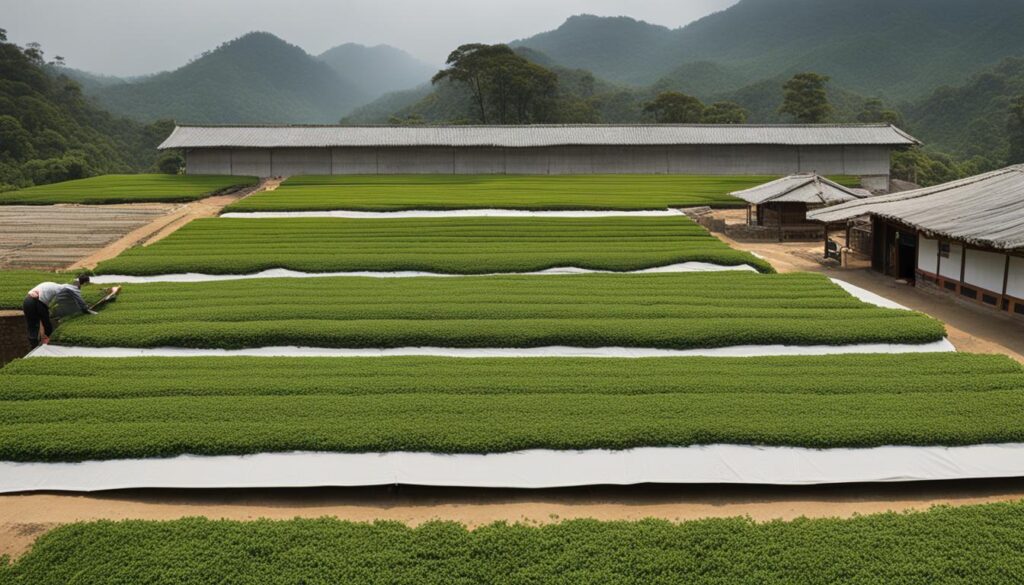
Types of Black Tea
Black tea comes in various types, each with its own unique flavors and characteristics. From bold and malty to floral and delicate, here are some popular variations:
Assam Tea
Assam tea is known for its strong and robust flavor. Grown in the northeastern region of India, this tea has a rich, malty taste that pairs well with milk and sugar. It is often used as the base for breakfast blends.
Darjeeling Tea
Darjeeling tea is a prized tea from the Himalayan region of India. It offers a lighter and more delicate flavor compared to Assam tea. Known as the “champagne of teas,” Darjeeling tea has floral notes and a refreshing quality.
Earl Grey Tea
Earl Grey tea is a classic blend infused with the essence of bergamot oil. This citrusy addition gives the tea a unique and aromatic flavor. It is a popular choice for afternoon tea and is often enjoyed with a slice of lemon or a splash of milk.
Ceylon Tea
Ceylon tea is grown in Sri Lanka and comes in a range of flavors. Light and delicate Ceylon teas have floral and citrusy notes, while bold and robust options offer a stronger taste. Ceylon tea is versatile and can be enjoyed plain or with milk and sugar.
Chinese Black Tea
Chinese black tea, such as Keemun tea, is renowned for its complex and wine-like flavor profile. It offers a smooth and malty taste with hints of fruit and cocoa. Chinese black teas are often enjoyed on their own or paired with savory dishes.
Each type of black tea provides a distinct and enjoyable experience, so feel free to explore and discover your favorite flavors!
Health Benefits of Black Tea
Black tea offers a myriad of health benefits, making it a popular choice among tea enthusiasts. Packed with antioxidants, it helps combat oxidative stress, promoting overall well-being. Studies suggest that regular consumption of black tea can contribute to heart health, improve mental alertness, aid digestion, and support the immune system.
Antioxidants for a Healthy Body
Black tea contains powerful antioxidants, such as theaflavins and catechins, which help protect the body against free radicals. These antioxidants neutralize harmful molecules, reducing the risk of chronic diseases and promoting cellular health.
Heart Health and Blood Pressure
Drinking black tea may have positive effects on heart health. Research indicates that regular consumption of black tea could help lower blood pressure and improve cholesterol levels. The flavonoids found in black tea have been shown to support cardiovascular health.
Mental Alertness and Concentration
The natural caffeine content in black tea provides an energy boost, enhancing mental alertness and concentration. It stimulates the central nervous system, promoting focus and cognitive performance. A cup of black tea can be a great way to start the day or stay productive throughout the afternoon.
Promoting Digestive Health
Black tea contains compounds, such as tannins, that may aid digestion and promote gut health. Tannins help regulate the digestive system by reducing inflammation and supporting the growth of beneficial gut bacteria. Enjoying a cup of black tea after a meal can help soothe digestion.
Boosting the Immune System
The polyphenols present in black tea have immune-boosting properties, strengthening the body’s natural defense system. These compounds help fight off infections and promote a healthy immune response. Including black tea in your daily routine may contribute to a robust and balanced immune system.
With its abundance of antioxidants, heart-healthy properties, mental alertness benefits, digestive support, and immune-boosting effects, black tea is a wonderful addition to a balanced lifestyle. Whether enjoyed hot or cold, black tea offers not only a delightful taste but also numerous health advantages.
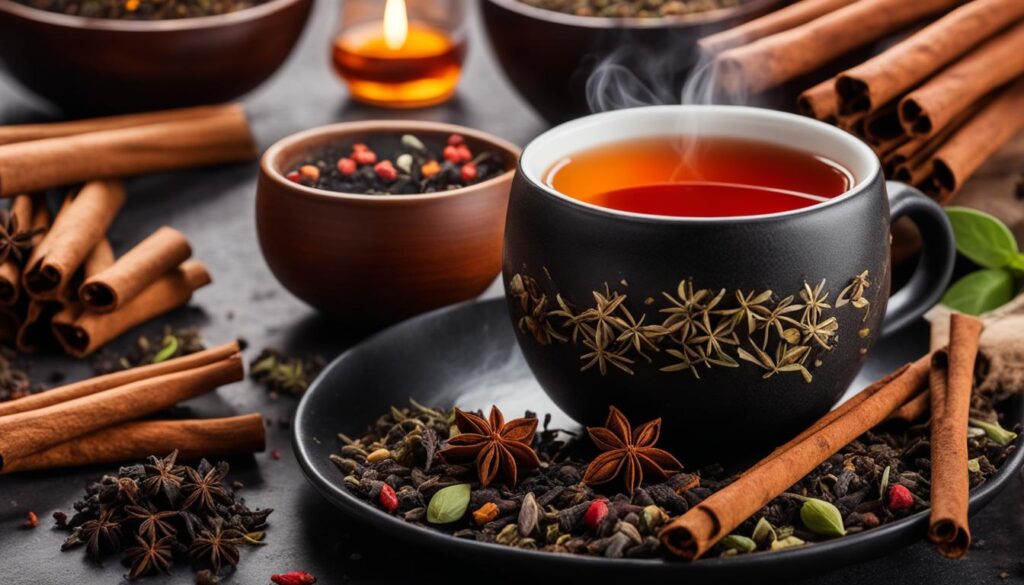
The Origins of Black Tea
Black tea has a rich history that dates back over 4,000 years to the Shang Dynasty in China. It is believed to be one of the earliest forms of tea to have been discovered. What sets black tea apart from other types of tea is the process of oxidation, also known as fermentation.
During the production of black tea, the leaves undergo a meticulous process that involves withering, rolling, oxidation, and drying. This careful process brings out the bold flavors and distinctive characteristics that black tea is known for.
Black tea’s origins in China and its unique production method make it a fascinating and beloved beverage around the world. Let’s explore the journey of black tea from ancient China to our teacups today.
“Black tea’s origins in China can be traced back to the Shang Dynasty, a period that spanned from 1600 BCE to 1046 BCE. It is during this time that tea leaves were first discovered and appreciated for their aromatic and stimulating properties.”
The Process of Oxidation
To better understand black tea, it’s important to explore the process of oxidation, also known as fermentation.
During oxidation, the tea leaves naturally interact with oxygen, which triggers a series of chemical reactions. This process is carefully controlled to achieve the desired level of oxidation and develop the unique flavors of black tea.
After the leaves are plucked, they are spread out to wither, which reduces their moisture content. This step prepares the leaves for the next stage of production.
Next, the withered leaves are rolled, which releases the essential oils within them. Rolling also helps to shape the leaves and initiate the oxidation process.
Once the leaves are rolled, they are left to oxidize in a controlled environment, where enzymes in the leaves interact with oxygen. This step is crucial for the development of black tea’s bold flavors and deep color.
After the desired level of oxidation is achieved, the leaves are dried to halt the oxidation process and preserve the unique characteristics of black tea. The drying process also helps to enhance the shelf life of the tea.
A Visual Journey of Black Tea Production
To visualize the journey of black tea production, here is a table outlining the key steps:
| Production Step | Description |
|---|---|
| Withering | Leaves are spread out and moisture content is reduced. |
| Rolling | Leaves are rolled to release essential oils and shape them. |
| Oxidation | Leaves are left to interact with oxygen, developing flavors and color. |
| Drying | Leaves are dried to halt oxidation and preserve characteristics. |
Through these steps, the journey of black tea production brings forth the bold and distinct flavors that tea lovers cherish.
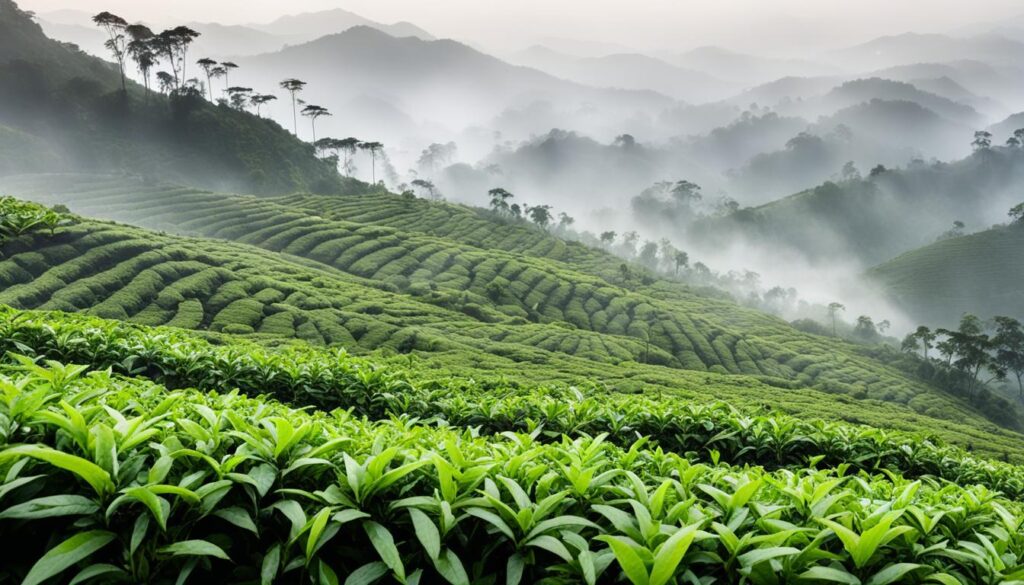
The Art of Producing Black Tea
Producing black tea requires precision and expertise. It is a meticulous process that involves several carefully executed steps to create the distinctive flavors and characteristics that black tea is known for.
After the tea leaves are plucked, they undergo a crucial stage called withering. During withering, the leaves are spread out and exposed to warm, dry air. This process reduces the moisture content in the leaves, making them pliable and ready for the next step.
Next, the withered leaves are rolled to release essential oils. Rolling the leaves helps to break down cell walls, allowing the tea’s natural flavors and aromas to be released. This step is crucial in ensuring the optimal taste and aroma of the final black tea product.
The duration of oxidation determines the flavor and color of black tea.
Following the rolling process, the tea leaves undergo oxidation, also known as fermentation. This stage is where the magic happens. The leaves are spread out and exposed to controlled humidity, allowing them to naturally ferment. The duration of oxidation plays a vital role in determining the flavor, aroma, and color of the black tea. Shorter oxidation periods result in lighter flavored teas, while longer oxidation periods lead to deeper and richer flavors.
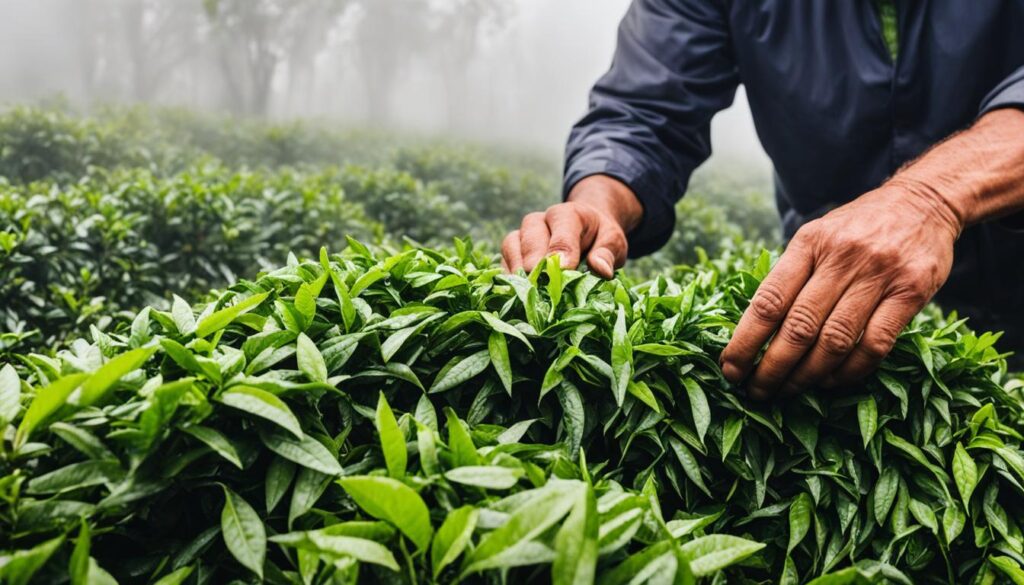
Finally, the leaves are dried to halt the oxidation process and preserve the unique characteristics of black tea. Drying removes any remaining moisture, ensuring the tea leaves are stable, ready for packaging, and can be enjoyed for an extended period.
The art of producing black tea lies in the careful execution of each step, from withering to rolling, oxidation, and drying. It is this precision and expertise that result in the delightful flavors and captivating aromas that black tea enthusiasts appreciate.
The Sensory Experience of Black Tea
The cool weather during the monsoon season enhances the sensory experience of black tea. As the temperature cools, taste buds become more sensitive to flavors, allowing the complexity of black tea to shine. The aroma of tea brewing plays an essential role in taste perception, amplifying the overall flavor and satisfaction. This connection between temperature, taste buds, and aroma contributes to the comforting experience of sipping black tea.
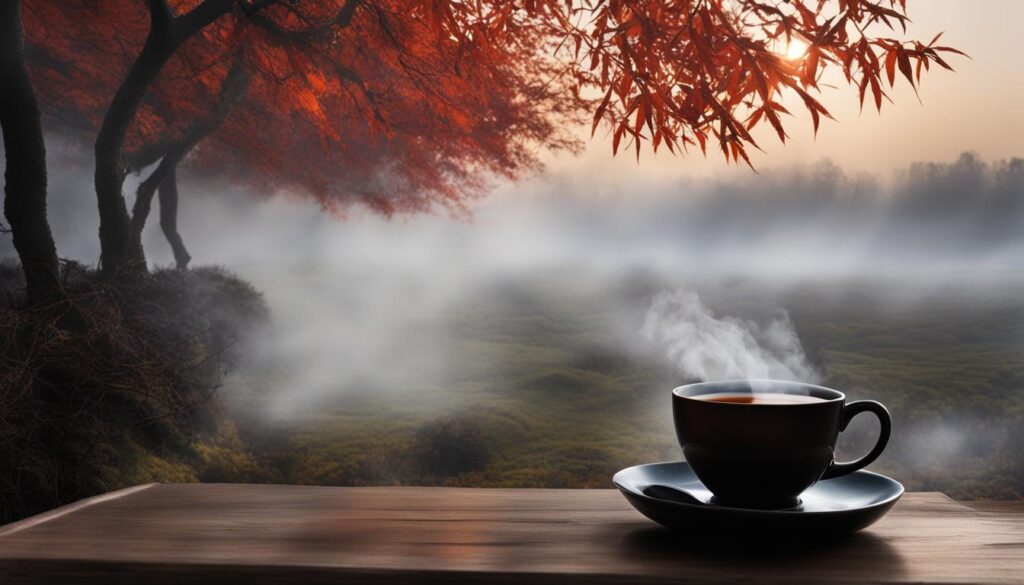
The Influence of Cool Weather on Taste Perception
In the cool weather, our taste buds respond differently to the flavors of black tea. As the temperature drops, our taste buds become more receptive, picking up subtle nuances and undertones that would otherwise go unnoticed in warmer weather. This heightened sensitivity allows us to fully appreciate the richness and complexity of black tea.
“The cool weather adds a certain crispness to the air, which has a direct impact on our taste buds. This makes it the perfect time to indulge in the aromatic and flavorful experience of black tea.” – Tea master Claire Thompson
Aroma: The Gateway to Taste
The aroma of black tea brewing is not just a pleasant scent; it actually enhances our perception of taste. The volatile compounds released during the brewing process stimulate the olfactory receptors in our nose, creating a synergy between aroma and taste. This synergistic effect intensifies the overall flavor experience, making each sip of black tea more satisfying.
Creating a Comforting Environment
During the monsoon season, enjoying a cup of black tea becomes a ritual that provides comfort and warmth. The combination of cool weather, the soothing aroma of tea, and the anticipation of savoring its flavors creates a cozy and inviting atmosphere. This sensory experience of black tea enhances relaxation and offers a sense of well-being.
The Comfort of Black Tea During the Rainy Season
Black tea provides warmth and comfort during the rainy season, offering a delightful respite from the gloomy weather. Not only does it satisfy our taste buds, but it also has a remarkable effect on our body temperature, providing a soothing and cozy experience.
When we sip a cup of hot black tea, the warm liquid raises our body temperature, creating a sense of comfort and relaxation. It’s like being wrapped in a cozy blanket on a rainy day, shielding us from the chill in the air. The gentle steam rising from the cup further enhances the overall sensory experience, stimulating our senses and evoking feelings of warmth and safety.
In addition to the physiological impact, the act of drinking black tea during the rainy season holds significant cultural traditions and symbolic meaning. Throughout history, many cultures have cherished the ritual of tea drinking, especially during times of inclement weather. It is a time when friends and family gather together, seeking solace and connection. By observing the cultural traditions surrounding black tea, we can embrace a sense of belonging and find comfort in shared experiences.
The warmth of a cup of black tea embraces both body and soul, comforting us in the midst of rainy days and reminding us of the cultural significance it holds.
So, on a rainy day, as you listen to the pitter-patter of raindrops on your windowpane, why not indulge in a cup of perfectly steeped black tea? Let its warmth envelop you, soothing your senses and transporting you to a place of comfort and tranquility.
| Benefits of Black Tea During the Rainy Season |
|---|
| 1. Increases body temperature, providing warmth and comfort |
| 2. Evokes feelings of coziness and relaxation |
| 3. Holds cultural significance and traditions |
| 4. Promotes a sense of belonging and connection |
The Timeless Tradition of Black Tea
Black tea holds a special place in our hearts and cultures, steeped in rich tradition and cultural significance. It is more than just a beverage; it is a symbol of comfort, a ritual that connects us to our roots. From the British tradition of afternoon tea to tea ceremonies in Asia, black tea rituals bring people together and create moments of solace and reflection.
Preparing and savoring black tea becomes a mindful practice, a way to pause and appreciate the present moment. The aroma that fills the room as the tea steeps, the warmth of the cup in our hands, and the comforting flavors that dance on our taste buds transport us to a state of tranquility. It is a time to unwind, embrace the stillness, and find comfort in the simplicity of a cup of black tea.
In addition to its cultural significance, black tea offers a myriad of health benefits. Packed with antioxidants, it supports our overall well-being and promotes a healthy immune system. As we sip on black tea, we can feel the warmth spreading through our bodies, soothing our souls and providing a sense of comfort. It’s no wonder that black tea has stood the test of time, captivating generations with its flavors, benefits, and rituals.
So, let us embrace this timeless tradition of black tea. Whether it’s indulging in a cup of afternoon tea with loved ones or finding solace in a quiet moment with a steaming cup in hand, may the rituals of black tea bring us comfort, connection, and a gentle reminder to slow down and savor life’s simple pleasures.
FAQ
What are the ingredients in black tea?
Black tea is made from the leaves of the Camellia sinensis plant. It contains caffeine and various other compounds that contribute to its flavor and health benefits.
Is organic black tea available?
Yes, organic black tea is available. It is made from tea leaves that have been grown without the use of synthetic pesticides or fertilizers.
What are some popular types of black tea?
Some popular types of black tea include Assam black tea, Darjeeling black tea, Earl Grey tea, English Breakfast tea, Ceylon black tea, and Chinese black tea.
What is the difference between Assam and Darjeeling black tea?
Assam black tea is known for its bold, malty flavor, while Darjeeling black tea offers a lighter, more floral taste.
What is Earl Grey tea?
Earl Grey tea is a classic blend of black tea that is infused with the oil of bergamot, a citrus fruit, giving it a unique flavor.
What is the manufacturing process of black tea?
Black tea is made through a process that includes withering, rolling, oxidation (fermentation), and drying. There are two main production methods: the traditional “orthodox” method and the newer “unorthodox” method.
What health benefits does black tea offer?
Black tea is rich in antioxidants and has been linked to heart health, improved mental alertness, digestive health, and immune support.
Where did black tea originate?
Black tea originated in China and is believed to have been discovered over 4,000 years ago during the Shang Dynasty.
How is black tea produced?
Producing black tea involves withering the tea leaves, rolling them to release essential oils, oxidizing them to develop flavor, and then drying them to halt the oxidation process.
What is the sensory experience of black tea like?
Black tea is enhanced during cool weather, as taste buds become more sensitive to flavors. The aroma of brewing tea also plays a significant role in taste perception.
Why is black tea comforting during the rainy season?
Black tea aids in thermoregulation, as the warmth of the tea raises body temperature, creating a sense of comfort and relaxation. Additionally, holding a warm cup of tea evokes feelings of warmth and safety.
What is the cultural significance of black tea?
Black tea has a timeless tradition and is often associated with tea rituals and daily routines. It is celebrated for its rich flavors, health benefits, and cultural connections.